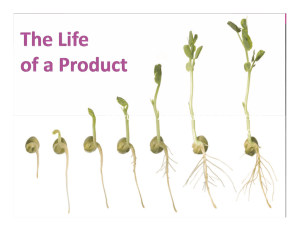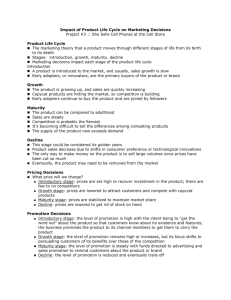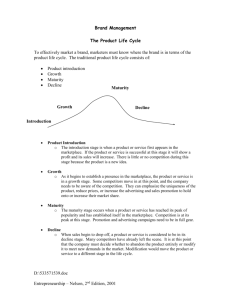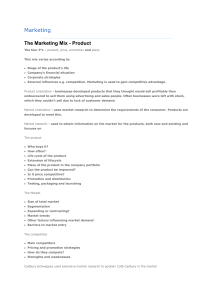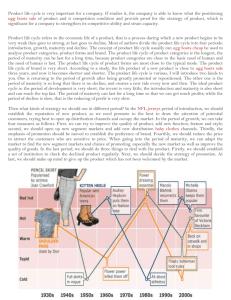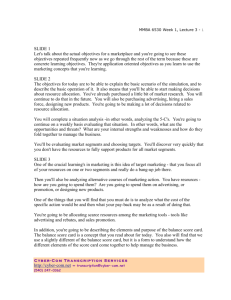SLIDE 1 We're going to be continuing on, to understand marketing
advertisement
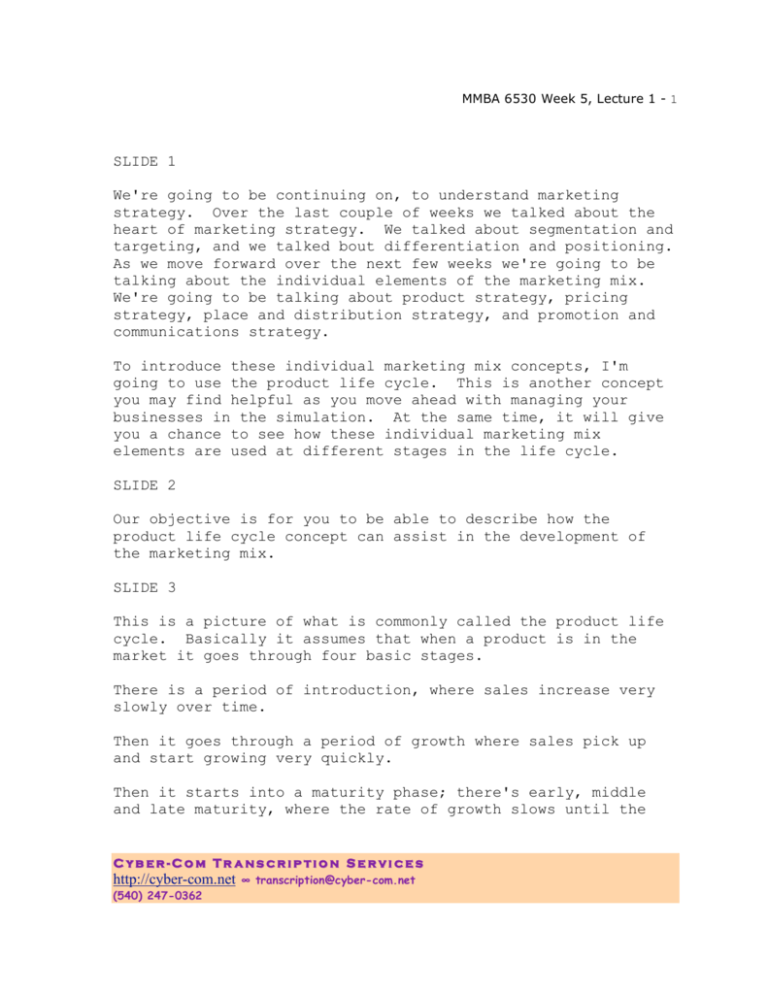
MMBA 6530 Week 5, Lecture 1 - 1 SLIDE 1 We're going to be continuing on, to understand marketing strategy. Over the last couple of weeks we talked about the heart of marketing strategy. We talked about segmentation and targeting, and we talked bout differentiation and positioning. As we move forward over the next few weeks we're going to be talking about the individual elements of the marketing mix. We're going to be talking about product strategy, pricing strategy, place and distribution strategy, and promotion and communications strategy. To introduce these individual marketing mix concepts, I'm going to use the product life cycle. This is another concept you may find helpful as you move ahead with managing your businesses in the simulation. At the same time, it will give you a chance to see how these individual marketing mix elements are used at different stages in the life cycle. SLIDE 2 Our objective is for you to be able to describe how the product life cycle concept can assist in the development of the marketing mix. SLIDE 3 This is a picture of what is commonly called the product life cycle. Basically it assumes that when a product is in the market it goes through four basic stages. There is a period of introduction, where sales increase very slowly over time. Then it goes through a period of growth where sales pick up and start growing very quickly. Then it starts into a maturity phase; there's early, middle and late maturity, where the rate of growth slows until the Cyber-Com Tr anscrip tion Services http://cyber-com.net (540) 247-0362 ∞ transcription@cyber-com.net MMBA 6530 Week 5, Lecture 1 - 2 product sales just flatten out over time. And then, the theory says that products will go into a period of decline and sales will start to taper off over time. This can be a very helpful concept in order to understand how the products evolve over time. At the same time, it can be a little misleading, because I'm sure you’ve heard of the concept of the self-fulfilling prophecy. If for example you have a slow month in sales, you might make the assumption that you're in decline and pull all support for the product. And that would kill the product. So the product life cycle is a great help in understanding how certain things happen at different times. But you have to be a little cautious sometimes in how you use it. SLIDE 4 Starting out understanding the cycle, one of the very first things you need to understand is that that particular shape of the cycle is very rarely seen. Instead there are other, similar shapes. This first one, for example, is the life cycle of a mature market with a long life cycle. For example, you might see automobiles here, or you might see, within the food industry, some brands that have been going on for many years. Think for example of Cheerios, the cereal, or think of Ivory soap. Some products are in maturity and have been there for a very long time, and will continue to be there for a long time. Now, what happens is that as these products, if they start to decline a little bit, the companies that have those brands will increase the support just a little in order to them back (to) top-of-mind with their consumers. But these are the products that go on forever in maturity, provided they get a little bit of periodic support. Cyber-Com Tr anscrip tion Services http://cyber-com.net (540) 247-0362 ∞ transcription@cyber-com.net MMBA 6530 Week 5, Lecture 1 - 3 SLIDE 5 This next shape of the life cycle is called a scalloped life cycle. It basically means that sales pass through a succession of life cycles, based on the discovery of new uses for the product. For example think about nylon. In World War II era, that was used primarily for nylon stockings, and it has evolved into use in parachutes; and so many clothes that we all wear today are made of nylon. Another great example of a soda. This was originally I’m sure that you've heard baking soda that are being scalloped life cycle is baking developed to use in baking, and now of at least 10 or 15 other uses for actually advertised by the company. SLIDE 6 This next one is called the cycle-recycle, and it's a very, very common form of the life cycle. Basically it means that when the sales start to decline the company pumps some support back into the product to give it a little bit more life before it starts to die off. You see this fairly frequently with pharmaceuticals. When their patents are about to expire they'll pump them back up a little bit again for a while, and then slowly they will start to decline. SLIDE 7 This one is called the growth-slump maturity cycle, and you've seen this one. This one is when there is a product that meets a real market need, but it's a durable: it's something that someone buys for their house, and then keeps in their house. So think for example of a food processor, or an electric carving knife. When it's first introduced, lots of people buy them, and they get one in each household. Then once there's one in each household sales basically taper off. Then you only see sales come back in as people replace them or as new households are formed. Cyber-Com Tr anscrip tion Services http://cyber-com.net (540) 247-0362 ∞ transcription@cyber-com.net MMBA 6530 Week 5, Lecture 1 - 4 SLIDE 8 And this last form is called the fad. It makes sense, right? It goes up, it comes down immediately. Think about the pet rock, or Cabbage Patch dolls. These products are fads. They come and they go quickly, normally because they really don't fill a need in the market, other than the need for novelty. People need that novelty, but it doesn't last for very long. After all, it's not a novelty after just a little bit of time. SLIDE 9 When you think about using the product life cycle as a tool in helping to understand how to develop marketing strategy, the first thing to understand is what's going on at each one of these stages of the cycle. Let's talk first about the introduction stage. Sales at the introductory stage are very low. That makes sense. You're just introducing the product into the market and there aren't very many people buying it. So your costs as a result are very high on a customer by customer basis. Your profits are negative. The types of customers who are buying your product are innovators: they're people who are trying something new because they really enjoy doing that. And typically there aren't very many competitors, especially if this is a new category. Then as the product starts to take off, obviously sales start to rise pretty rapidly. The costs per customer start to come down, and you start to actually see some profits come in. In terms of customers you start to see another group of customers start to adopt the product. You've read about these in Geoffrey Moore's book, Crossing the Chasm, where this next group of people are the early adopters. They're the people who will try a new product as long as they know for sure that it's going to do something for them. And of course once a product is in growth stage, competitors start to see that there's a possibility for some business there, and so they Cyber-Com Tr anscrip tion Services http://cyber-com.net (540) 247-0362 ∞ transcription@cyber-com.net MMBA 6530 Week 5, Lecture 1 - 5 will launch products into the market to compete with you. As you move into the maturity stage, sales start to slow in terms of their growth rate, and then they start to peak and level off. So your costs at this stage have come down much further on a cost per customer basis. This is where you're seeing the most profitability. And the customers tend to be that middle majority group that you read about in Crossing the Chasm. In terms of competitors, well, think back to Porter's five forces, and what’s happening in an industry when you start to get lots of competitors. Remember that profit levels start to come down just a little bit, because there's more and more competition; they're starting to slug it out and your margins are starting to come down. So what happens here, at this stage in maturity, is that you start to see the number of competitors start to level off and maybe even start to drop out. And then finally in the declining stage, obviously sales are starting to decline. The cost per customer is still pretty low. Profits, though, are starting to come down, and the people who are buying your product for the first time tend to be those laggards. They're the ones who were really not very interested in the first place. That's actually one of the signs that your product might be in decline. If you do some consumer research on those folks and find out who it is that's buying that product and what their attitudes are towards these categories of products, you'll start to discover that these are probably the laggards. And of course, as the market gets smaller, there's really not much there in the way of sales any more. The market becomes less attractive for competitors. So this particular cycle can really help you in terms of thinking about how you would want to manage your marketing strategies over that term. SLIDE 10 Remember that we've also talked about objectives. Cyber-Com Tr anscrip tion Services http://cyber-com.net (540) 247-0362 ∞ transcription@cyber-com.net We talked MMBA 6530 Week 5, Lecture 1 - 6 about the marketing marketing marketing cycle. difference between financial objectives and objectives. We're going to be talking purely about objectives here, and what are the objectives from a standpoint at each one of these stages in the life During the introductory stage, you need to create awareness and trial. That makes total sense. Nobody's going to buy your product until they're aware that it exists. And then nobody's going to buy it on a regular basis until they've tried it. So your marketing strategies, your marketing mix strategies as you'll see in a few minutes, are going to be focused on getting awareness and getting trial. As you move into the next stage, growth, your objective is to maximize your market share. Remember that as your sales are going up you also have competitors coming in, and so your sales are going up together. So you want to sustain the growth as long as possible but you also want to keep gaining market share to stay ahead of your competition. As sales start to level off in the maturity section, you need to think about maximizing your profit while at the same time defending share. Remember, in maturity, you have all these competitors who are starting to slug it out for this business. So you have to defend your business while at the same time making sure that you're making enough money, if only to fund this business – and also to fund new businesses that you have coming down the road. And then as you move into the decline stage, you reduce expenditures and you milk the brand. Remember what I said a few minutes ago? One of the real difficulties with the product life cycle is that -- if you mis-estimate where you are in the cycle, and you come to the conclusion that you're in decline when in reality you're just having a bad quarter, and you use this general marketing objective of reducing expenditure and milking the brand -- the sales are going to decline automatically once you reduce expenditures and milk Cyber-Com Tr anscrip tion Services http://cyber-com.net (540) 247-0362 ∞ transcription@cyber-com.net MMBA 6530 Week 5, Lecture 1 - 7 the brand. So while the product life cycle is a very helpful tool, you have to be very careful not to take it all on face value. SLIDE 11 The next question then is, we know what your objectives are at the various stages, so what are the marketing mix strategies that you would use? One of the key things that you're going to get coming out of this is that your strategies are actually going to shift as you move from one stage to the next. When you're first introducing a new product into the market, you need to offer a basic product. There are no frills to add confusion. For example, remember the Newton? The Newton was one of the very first personal digital assistants. It was a fabulous product, but at the same time it confused people; it did so many things. When the Palm Pilot came out, the president of the company for the Palm Pilot insisted that this be a very, very simple tool, and that it carry only a few things. It was an address book, a to-do list, a calendar and a memo pad. And those were really the only four things it would do. There are stories about the design of the Palm Pilot, that the fabulous engineers they had in the company continually wanted to add new features to it, but at that particular point in time the president of the company was saying hold those features off for later. We want to introduce a very simple product at this point, to introduce them to this new concept, this new product category, of a personal digital assistant. So a basic product is something that's very simple for people to understand and they can get started with it. From a pricing standpoint, it's very important to try to think in terms of what your product offers the customer in terms of value. What kind of money can they save by using your product Cyber-Com Tr anscrip tion Services http://cyber-com.net (540) 247-0362 ∞ transcription@cyber-com.net MMBA 6530 Week 5, Lecture 1 - 8 compared to somebody else’s? And try to think about how to put a price on that product that really connects to the value that people get from it. That's difficult to do and we'll spend a fair amount of time talking about that next week. A very common pricing strategy that you see during the introductory stages is cost plus. This is especially common in business-to-business and in engineering firms. It means that you take whatever your costs were and you add a certain profit margin on top of it. That's actually not the optimum strategy and we'll talk more about that next time. But it's a frequent strategy that's used. And finally, two very frequent introductory strategies are either skimming on one hand, or penetration on the other. With a skimming strategy, you have a product that, when people see it, they want badly. It's a product where you're pricing it as high as you can in those early days for that first target segment, the ones who are the innovators and who want it very badly. You price it very, very high so that you can start to recover some of those R&D costs that you put into it. This works really well if you don't have a lot of competition coming behind you and if it's the kind of product where, the minute customers see it, the minute your target sees it, they want it and they're willing to pay whatever the cost is, whatever the price is. Penetration strategies on the other hand are another way of starting off. A penetration strategy means you price very, very low because you want to penetrate that market and get as many people buying that product as you can in the short term. You would want to do that if you see competition coming, breathing down your neck very quickly, and you want to get into the market as far as you can and get as much market share as you can, as quickly as you can, in order to hold off the competition. So that's pricing strategy, and you can do a couple of things Cyber-Com Tr anscrip tion Services http://cyber-com.net (540) 247-0362 ∞ transcription@cyber-com.net MMBA 6530 Week 5, Lecture 1 - 9 during the introductory stage. We'll talk more about these in detail in the individual sections. In terms of place and distribution strategy, this seems kind of intuitive. When you start out with introducing the product you start with selective distribution. You only distribute it a few places: only a few places where your target prefers to shop. Remember you're starting out with a fairly narrow initial target. Remember the invasion of Normandy, in Crossing the Chasm? You're starting out with a fairly small segment, so you only build distribution into that small segment. You don't want to build more distribution than you can handle. You wouldn’t want to build lots of distribution and then not have the capacity to fulfill all those channels. You start it with a very small, selective distribution. In terms of promotion, you have both advertising and you have sales promotion. A quick rule of thumb to remember about advertising and sales promotion is that advertising gives people a reason to buy, and sales promotion gives people an incentive to buy. So advertising is something that builds over the long term. It's building an attitude. Remember how we measured attitudes and purchase intent during the Fishbein analysis? So advertising helps to build attitude in people, and sales promotion gives them an incentive to buy something right now. So it might be a price cut, it might be a coupon, it might be a discount, it might be an offer to buy one get one free. But it's an incentive to act right now. So what you're doing with advertising in the introductory stage is building awareness. You're trying to get the word out, especially to the early adopters, the innovators, and the dealers. Then in terms of sales promotion, remember that the second big objective during introduction is trial. Awareness and trial. So heavy sales promotion, which gives people an incentive to buy right now, will get them to try the product. So that's how you use the marketing mix during the introductory stage. Cyber-Com Tr anscrip tion Services http://cyber-com.net (540) 247-0362 ∞ transcription@cyber-com.net MMBA 6530 Week 5, Lecture 1 - 10 SLIDE 12 When you move into the growth stage, then you start adding some additional extensions. You can add more features to the product because this makes it attractive to a broader group of people. You’re moving from one target perhaps into another. You price to penetrate the market, so at this point you start to bring the price down, because remember you're starting to see some competition here. In terms of distribution, you start moving out to more distribution channels. You build awareness and interest in the mass market, the bigger market. And at this point you actually start reducing your sales promotion because the advertising and the distribution and the price are helping to get you to take off. You have some momentum going, so we don't need to spend money on promotion right now: save it for something else. SLIDE 13 As you move into the mature stage, then you have to start diversifying in terms of more brands and more models. At this point your pricing is going to have to match or better your competitors. In terms of distribution you're looking for even more intensive distribution. Perhaps you go into foreign markets. As you continue into maturity remember that you have competitors there, and so you have to figure out a way to build preference among those target customers, and stress the differences between your brand and competitors' brands, and what the benefits are that your product offers compared to competitors. And then of course we're back to sales promotion again. You’re trying to get people to switch from other brands, from competitors' brands to yours, so here you need incentives. So we're back to using sales promotion again. Cyber-Com Tr anscrip tion Services http://cyber-com.net (540) 247-0362 ∞ transcription@cyber-com.net MMBA 6530 Week 5, Lecture 1 - 11 SLIDE 14 Then as you move into decline, assuming you really are in the decline stage, the first thing you have to do is start phasing out weak items. This is really hard to do because every product has a champion. Within the organization lots of people don’t want to kill products - they really like that product. So as a result lots of companies have tens of thousands of stock keeping units that are taking up shelf space in their warehouses. But it's really important here to bite the bullet and when you have a weak item you need to let it go. Prices start coming down. In terms of distribution, instead of being broad as you were, now distribution starts to narrow back, to phasing out unprofitable channels and zeroing in on the ones that your loyal customers are using. In terms of advertising, you start to reduce this and only enough to hang on to and kind of reward your most loyal customers. And sales promotions pretty much get reduced to a minimal level at this point. So those are the strategies over the course of the life cycle. SLIDE 15 That acts as a good introduction for you to what are the elements of the marketing mix, and how the product life cycle can be used to help guide which strategies of the mix Cyber-Com Tr anscrip tion Services http://cyber-com.net (540) 247-0362 ∞ transcription@cyber-com.net

